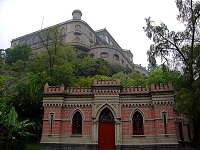
Bosque de Chapultepec is a truly immense urban park. Mexico's answer to Central Park spans over 686 hectares (1,695 acres), and on any given day is brimming with people. The park is home to boating lakes, monuments, a zoo, playing fields, and Chapultepec Castle. The castle stands on a hill in the centre of the park, housing the Natural History Museum and offering incredible views of the city. There's plenty to see and do in the park, but most people come to relax on lunch breaks or weekends. Kick back, grab a taco and indulge in some people-watching.
Address : Bosque de Chapultepec I Secc, 11100 Mexico City, CDMX, Mexico
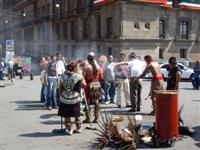
The enormous paved Plaza de la Constitucion, or Zocalo, is the second largest city square in the world. Dominated on one side by the magnificent colonial Presidential Palace, and on the other by the great Metropolitan Cathedral with its ornate interior, the square is Mexico City's centre of government and religion. The square itself is always filled with activity, with vendors and buskers, informal traditional Aztec dance performances, family groups, workers on lunch break and passing tourists. Every evening the presidential guards, in a show of great ceremony, lower the national flag from the central flagpole. The square is constantly encircled by the city's ubiquitous green Volkswagen taxis, and is a good starting point for those wanting to explore the city.
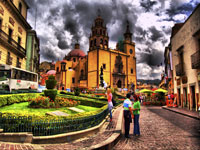
Guanajuato is a colonial gem, founded around the rich silver deposits discovered by the Spanish in 1558. The city has an unusual layout, crammed into a narrow valley, with houses and streets forced into irregular positions due to the naturally hilly topography. Brightly painted houses perch on slopes reached by narrow cobbled alleyways, hidden plazas, steep stairways and underground tunnels. The most narrow, and most visited, alley is the Callejón del Beso (Alley of the Kiss) where the balconies of the leaning houses on either side almost touch each other, a feature in the local romantic legend about furtive lovers exchanging kisses. Every weekend the famous strolling musicians, or callejoneadas, in traditional dress, lead processions through the narrow winding alleyways, strumming, singing and telling stories to the crowds that follow.
Transport : Bus from Mexico City (about four hours).
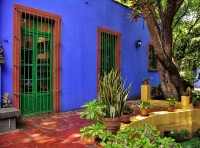
Formerly a separate village, San Angel is one of the more charming of Mexico's suburbs, an exclusive neighbourhood with ancient mansions and colonial houses along cobbled streets. It is famed for its Saturday craft market in the pretty Plaza San Jacinto, which brings colour, crowds and a festive atmosphere to the area, and has excellent art and handicrafts for sale. The suburb is crammed with little restaurants and cafes, several museums exhibiting the works of Frida Kahlo among others, and the lovely El Carmen complex consisting of a triple-domed church, a former monastery, school buildings, and a museum. San Angel is surrounded by a volcanic rock bed called the Pedregal. Parts of this unusual landscape have been declared protected areas where visitors can see the endemic flora and fauna.
Address : Southwest of Mexico City
Templo Mayor (Great Temple) was the principal temple of the Aztecs, believed to mark the centre of the universe. It was part of the sacred complex of the ancient city of Tenochtitlan, and today it has been excavated to show the multiple layers of construction. The temple was first built in 1375, and enlarged several times, each rebuilding accompanied by a frenzied bloody sacrifice of captured warriors to rededicate the sacred area. Within the site is the excellent Museo del Templo Mayor, displaying artifacts from the original site including a great wheel-like stone carving of the Aztec goddess of the moon, Coyilxauhqui. The entrance fee covers admission to both the museum and the archaeological site.
Address : Seminario 8, Historical District
Website : www.templomayor.inah.gob.mx/english
Telephone : +52 55 4040 5600
Transport : Take metro to Zocalo. Templo Mayor is off Zocalo, to the right of the city cathedral if you face it.
Opening times : Tuesday to Sunday 9am to 5pm.
Admission : MXN 64
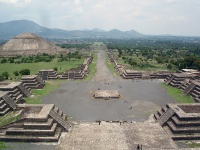
Situated 31 miles (50km) from Mexico City, the UNESCO World Heritage Site of Teotihuacan is Mexico's largest ancient city, dating from around 300-600 BC. Legend has it the Aztecs found the abandoned city and, recognising signs of its previous magnificence, they named it what it is today: Teotihuacan, 'place of the gods'. The central thoroughfare of Teotihuacan is the Avenue of the Dead, a 1.3 mile (2km) stretch connecting the three main attractions. The Pyramid of the Sun is the third largest pyramid in the world, a huge red painted structure over a cave with spectacular views from the top. The smaller, more graceful Pyramid of the Moon contains an alter believed to have been used for religious dancing. The Citadel is a large square complex that was once the residence of the city's ruler. Within the walls is its main feature, the Templo de Quetzalcoatl.
Telephone : +52 59 4956 0276/0052
Transport : Teotihuacan bus departs from Gate 8 of Mexico Citys Terminal del Norte every half hour
Opening times : Tuesday to Sunday 9am-5pm.
The Zona Rosa (Pink Zone) is Mexico City's major dining, nightlife and shopping district. It is a compact area crammed with bars, shops, boutiques, restaurants and hotels. The district has subtly shifted in its appeal recently. Once a fashionable hub for youth and the upper classes, the Zona Rosa is now also frequented by the city's gay community and tourists. The symbol of Mexico City, a gilded statue of Winged Victory which is the Independence Monument, looms above the district and is one of the city's most photographic features. There is accomodation available in the area, but visitors are advised that it can be noisy at night.
Transport : Line 1 on the metro to Insurgentes Station.

Travel Guide powered by Word Travels, copyright © 2023 Globe Media Ltd. By its very nature information in this travel guide is subject to change at short notice and travellers are urged to verify information on which they're relying with the relevant authorities. Neither Globe Media Ltd nor Travel Vogue can accept any responsibility for any loss or inconvenience to any person as a result of information contained above.